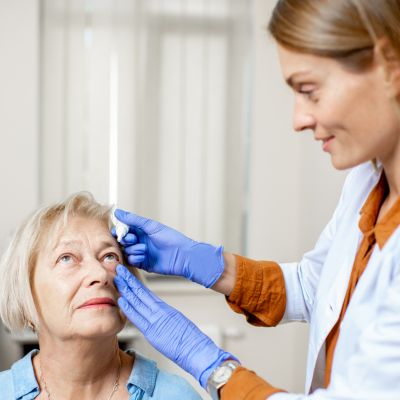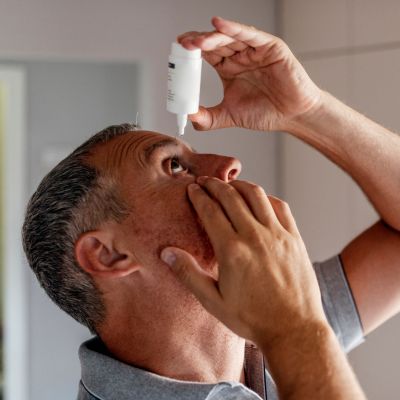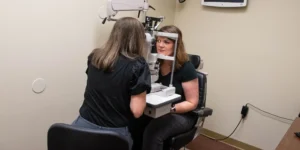
People often have various questions about eye drops. This is especially true if they’re using them for the first time or have specific concerns about their eye health. When talking to your Knoxville optometrist, it’s important to ask whatever questions you may have about eye drops. This will ensure you get the best results with a greatly reduced risk of complications.
Patients’ most common questions about eye drops include:
- How do I properly administer eye drops?
- Can I use eye drops with contact lenses?
- What should I do if I accidentally touch my eye with the dropper?
- How often should I use eye drops?
- What are the potential side effects of eye drops?
1. How Do I Properly Administer Eye Drops?
One of the most common questions about eye drops is how to apply them correctly. It can take some time to become comfortable with dropping liquid into your eye. Fortunately, practice makes perfect. Just be sure to follow these easy steps for the best results.
- Wash your hands thoroughly with soap and water
- Find a comfortable and well-lit space
- Tilt your head back slightly or lie down if that’s more comfortable for you
- Hold the bottle in one hand between your thumb and forefinger, making sure that it’s clean and not touching anything
- Using your other hand, gently pull down your lower eyelid with your index finger to create a small pocket
- Look up as you aim for the center of your eye
- Without touching your eye with the bottle, squeeze the drops into your eye. Apply the prescribed number of drops if your eye doctor instructed you to do so
- Use a clean towel to wipe away any excess liquid
- Put the cap back on and wash your hands again
There may be times when you’re using more than one type of eye drop. In cases like these, wait 5 – 10 minutes before applying different types of eye drops.
2. Can I Use Eye Drops with Contact Lenses?
You can use certain types of eye drops with contact lenses. However, you need to make sure that you choose the right type of drops and follow instructions carefully. Lubricating or rewetting eye drops designed for contact lenses are safe to use while wearing them. These are often over-the-counter (OTC) options that don’t require a prescription.
Using prescription and medicated eye drops while wearing contacts is a different story. Avoid using these and talk to your optometrist first. They may contain ingredients that affect the lens material, possibly resulting in discomfort or even damaging your eye.
Whatever type of eye drops you’re using, be sure to take your contacts out before applying them. You should also wait at least 15 – 20 minutes before putting them back in. This gives the drops time to begin working effectively. As always, make sure to thoroughly wash your hands before and after handling your contacts to avoid an eye infection.
3. What Should I Do if I Accidentally Touch My Eye with the Dropper? 
A lot of noise is made about not touching your eye with the dropper of the eye drop bottle. This is because it may introduce bacteria or other contaminants to your eye.
If this happens to you, make sure to:
- Stay calm and don’t rub your eye since that can worsen irritation
- Wash your hands with soap and water, preventing further contamination
- Take out your contacts if you’re wearing any to prevent contaminants from getting trapped between your eyes and the lenses
- Rinse out the affected eye. You can do this by rinsing your eye with clean, lukewarm water, blinking repeatedly, or using a saline solution
- Wait to see if discomfort or irritation starts or persists. Seek medical attention immediately if you experience severe pain, changes in vision, or persistent irritation
- Throw out the contaminated dropper and replace it with a new, clean one
- Prevent this from happening again by practicing or having someone help you apply eye drops
Taking proper precautions when using eye drops is key for preventing infections and eye injuries. Be sure to follow your eye doctor’s instructions when using eye drops as well as when recovering from an eye infection or injury.
4. How Often Should I Use Eye Drops?
How often you use eye drops depends on two main factors:
- The specific type of drops
- The underlying eye condition
For lubricating eye drops (artificial tears), it’s generally safe to use them as needed for relief from dryness or discomfort. However, it’s advisable not to exceed using more than every 1 – 2 hours.
Prescription and medicated eye drops should be used as directed by your optometrist. Typically, these are administered 1 – 2 times a day but can vary based on the severity of the condition.
Always follow your doctor’s or eye care specialist’s recommendations regarding the frequency of eye drop usage. Overusing eye drops, especially those containing medications, can lead to adverse effects and should be avoided. If you experience any unusual or worsening symptoms, consult a healthcare professional promptly.
5. What are the Potential Side Effects of Eye Drops?
Eye drops are commonly used to treat various eye conditions, but they can have potential side effects. These side effects may include:
- Burning or stinging
- Redness or irritation
- Blurry vision
- Dryness or watery eyes
- Allergic reactions
- Systemic effects
Eye drops can cause temporary burning or stinging when used. Similarly, they can result in redness or irritation in certain instances. Blurry vision can occur immediately after applying the drops, but this is temporary.
Allergic reactions can occur in rare instances resulting in itching, redness, or swelling. Systemic effects may arise if medications from eye drops are absorbed into the bloodstream. This can result in changes to your blood pressure and heart rate.
It’s crucial to follow your healthcare provider’s instructions and report any unusual side effects promptly. Avoid sharing eye drops with others to minimize the risk of infection or adverse reactions.
Need help choosing the right eye drops? Contact us today to schedule an appointment!
Make sure you administer eye drops correctly, including washing your hands thoroughly. Always remove contact lenses before using eye drops and wait a few minutes before putting them back in. If you touch your eye with the dropper, rinse your eyes using lukewarm water, blinking, or a saline solution. Follow your eye doctor’s instructions for frequency of use, and contact them immediately if you experience any complications.
Hardin Valley Eyecare & Optical has been serving Knoxville since 2009. Located at 10904 Spring Bluff Way, you can schedule an appointment online or give us a call at (865) 888-0892.






